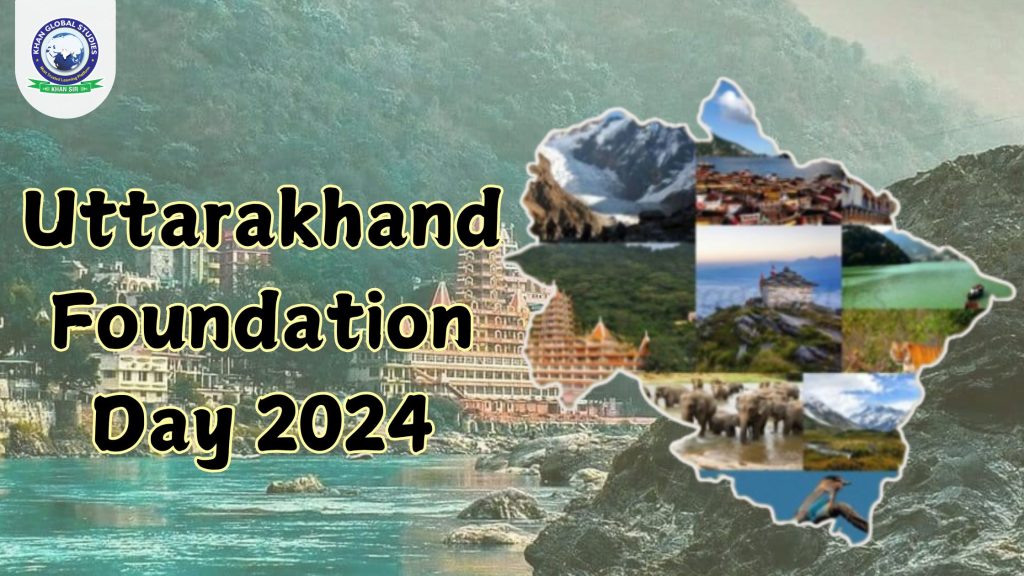Uttarakhand, also known as the “Land of the Gods” or Devbhoomi is a majestic state located in the northern part of India. Nestled in the lap of the Himalayas, the state is famous for its natural beauty, spiritual significance, and cultural heritage. The state has a variety of landscapes, from snow-capped high mountains to lush green valleys, tranquil rivers, and ancient pilgrimage sites.
History of Uttarakhand
The history of Uttarakhand is rich and deeply rooted in mythology and ancient Indian texts. The region finds mention in the Mahabharata and the Ramayana, indicating its spiritual significance since ancient times. Originally called Uttaranchal, the state was carved out of Uttar Pradesh on November 9, 2000. In 2007, its official name was changed to Uttarakhand, which better reflects its historical and cultural identity.
The history of Uttarakhand is intertwined with the lives of sages, saints, and gods. It has long been a haven for those seeking spiritual knowledge with many ancient temples and ashrams dating back centuries.
Uttarakhand State Movement
The formation of Uttarakhand was the result of a long and contested process. In the 1990s, people started a movement demanding a separate state for the Garhwal and Kumaon regions. This movement was led by Uttarakhand Kranti Dal and other organizations.
Many public meetings, rallies and protests took place during this movement. The Muzaffarnagar incident in 1994 further intensified the movement, when the police used force on the protesters. This incident brought the demand for a separate state to the national level.
Finally, on 9 November 2000, Uttarakhand was separated from Uttar Pradesh and formed a new state. Initially, it was named Uttaranchal, but in January 2007 it was renamed Uttarakhand, which means “region of the north”.
Geography and Region of Uttarakhand
Uttarakhand covers an area of about 53,483 square kilometres and is divided into two major regions:
- Garhwal
- Kumaon
Both regions have their own distinct culture, traditions, and landscape. The state is home to some of the most important rivers in India, including the Ganges, Yamuna, Alaknanda, and Sarayu. The Himalayas, dense forests, and ancient glaciers make Uttarakhand a paradise for nature lovers and adventurers.
Major Rivers and Mountains
The holy rivers Ganges and Yamuna originate from Uttarakhand, and the state is dotted with major peaks like Nanda Devi, Trishul, and Panchachuli. The terrain ranges from the plains near Haridwar to the rugged mountains near Badrinath and Kedarnath.
Flora and Fauna: Rich Biodiversity of Uttarakhand
Uttarakhand is famous for its biodiversity and has a wide variety of ecosystems. A significant portion of the state is covered with forests, and it is home to several national parks and wildlife sanctuaries. Some of the most notable of these are:
- Jim Corbett National Park – India’s first and oldest national park, famous for its population of Bengal tigers.
- Nanda Devi National Park – a UNESCO World Heritage Site known for its stunning landscape and unique flora.
- Valley of Flowers – Another UNESCO-listed site, the Valley of Flowers is a botanical paradise, home to rare alpine flowers and a diversity of endangered species.
Uttarakhand’s forests are rich with oak, pine and rhododendron trees. The state also has a wide variety of wildlife, including leopards, elephants, deer and a variety of bird species.
Spiritual Significance: Land of pilgrimages
Uttarakhand, often referred to as the “Land of Pilgrimage” or “Devbhoomi”, is a state where natural beauty and spirituality coexist in harmony.
The state is home to numerous sacred sites, attracting millions of devotees and tourists from across the globe. Uttarakhand’s ancient temples, holy rivers, and ashrams hold immense religious and spiritual significance, some of which date back thousands of years.
1. Char Dham Yatra – The Most Revered Pilgrimage Route – The Char Dham Yatra is Uttarakhand’s most famous religious circuit, comprising four sacred sites:
- Badrinath: Dedicated to Lord Vishnu, this temple is situated on the banks of the Alaknanda River. It is one of the four major Dhams in India and was established by Adi Shankaracharya.
- Kedarnath: A temple dedicated to Lord Shiva, located near the Mandakini River. It is one of the twelve Jyotirlingas, and its pilgrimage is considered spiritually rewarding despite its challenging terrain.
- Gangotri: The origin of the holy River Ganga, this temple is dedicated to Goddess Ganga. Situated in the high Himalayas, it draws thousands of pilgrims annually.
- Yamunotri: The source of the Yamuna River, this site is dedicated to Goddess Yamuna. The temple and hot springs here are major attractions for devotees.
2. Haridwar – Gateway to the Gods – Haridwar, located on the banks of the Ganges, is one of the holiest cities in India. It marks the spot where the Ganga descends to the plains.
- Har Ki Pauri: The most famous ghat, where the Ganga Aarti is a mesmerizing experience.
- Kumbh Mela: Held once every 12 years, it is the largest religious gathering in the world.
3. Rishikesh – The Yoga Capital of the World – Known as the “Yoga Capital of the World”, Rishikesh is another significant spiritual hub in Uttarakhand.
- Laxman Jhula and Ram Jhula: Iconic suspension bridges over the Ganges.
- Numerous ashrams offer yoga, meditation, and spiritual education, attracting visitors worldwide.
4. Hemkund Sahib – A Sikh Pilgrimage – Hemkund Sahib, a revered Sikh shrine, is situated at an altitude of 4,632 meters. Associated with Guru Gobind Singh Ji, it involves a challenging trek but offers breathtaking views and profound spiritual peace.
5. Tungnath Temple – The Highest Shiva Temple – The Tungnath Temple, at an altitude of 3,680 meters, is the highest Shiva temple in the world. It is one of the Panch Kedars, and the trek to Tungnath from Chopta is a favorite among pilgrims and trekkers alike.
6. Maa Nanda Devi Temple (Almora) – Dedicated to Maa Nanda Devi, the temple is a major center of worship in Uttarakhand. The Nanda Devi Mela, held annually, reflects the state’s rich cultural and religious heritage.
7. Patal Bhuvaneshwar (Pithoragarh) – Patal Bhuvaneshwar is an ancient cave that holds great religious importance, believed to house Lord Shiva and the pantheon of 33 crore deities. The cave’s mysterious and sacred aura draws many visitors.
8. Katarmal Sun Temple (Almora) – This 9th-century temple dedicated to Surya Dev (Sun God) is renowned for its architectural brilliance and historical significance.
Culture and Traditions of Uttarakhand
The culture of Uttarakhand is deeply rooted in its traditions, festivals, folk music and dance forms. The people of Uttarakhand celebrate a variety of festivals that reflect their connection to nature and spirituality.
- Folk Dances
- Chholiya Dance – Traditional sword dance performed at weddings and other festive occasions.
- Jhora and Chanchari – Popular folk dances of the Kumaon region.
- Festivals
- Harela – Celebrated to mark the onset of monsoon and sowing of crops.
- Ghee Sankranti – Festival to celebrate the first harvest of the season.
- Nanda Devi Mela – A festival dedicated to Goddess Nanda Devi, symbolizing the rich cultural heritage of the state.
Tourist Attractions in Uttarakhand
Uttarakhand is a treasure trove for tourists, offering a variety of destinations for nature lovers, adventure seekers, and spiritual travelers.
Hill Stations
- Mussoorie – Known as the Queen of Hills, Mussoorie offers stunning views of the Himalayas and is a popular destination.
- Nainital – Famous for its beautiful Naini Lake and surrounding hills, it is one of the most visited tourist destinations in Uttarakhand.
- Almora – A beautiful hill station famous for its temples and cultural heritage.
Adventure and Nature Tourism
- Auli – A major destination for skiing and other winter sports.
- Rishikesh – Famous for river rafting, bungee jumping and yoga retreats.
- Pithoragarh – Also known as Mini Kashmir, this beautiful valley offers spectacular views of the Himalayan ranges.
Economy of Uttarakhand
The economy of Uttarakhand is mainly driven by agriculture, tourism and hydropower. The state produces rice, wheat, millet, potatoes and apples in large quantities. Apart from this, cultivation of medicinal plants and herbs contributes to the economic growth of the state.
Tourism plays an important role in the economy of Uttarakhand. The state is visited by millions of tourists every year due to its natural beauty and its spiritual significance. Hydroelectric power generation also contributes significantly to the state’s economy, as so many rivers flow through the state.
Challenges and Opportunities for Development
Despite its beauty and resources, Uttarakhand faces several challenges:
- Landslides and floods during the monsoon season affect lives and infrastructure.
- Climate change is causing glaciers to melt, threatening the state’s water resources.
- Rural unemployment is leading to migration from villages to cities.
However, the state government is actively working on solutions, focusing on sustainable tourism, rural development, and disaster management. Initiatives to improve infrastructure and promote eco-tourism are helping Uttarakhand grow and flourish.
Conclusion
Uttarakhand is not just a state; it is a confluence of natural beauty, spirituality, and rich cultural heritage. From high peaks and sacred rivers to age-old traditions and modern tourist attractions, Uttarakhand offers something for everyone. Despite facing environmental and social challenges, the state is moving ahead with resilience and innovation. For those looking for peace, adventure or a spiritual experience, Uttarakhand is a place they must visit.
Frequently Asked Questions (FAQs)
Q: Why is Uttarakhand called “Devbhoomi”?
Answer: Uttarakhand has many holy pilgrimage sites, temples and religious places. The major sites of Chardham Yatra here, Badrinath, Kedarnath, Gangotri and Yamunotri are considered extremely sacred in Hinduism. That is why it is called “Devbhoomi”.
Q: What are the main tourist places in Uttarakhand?
Answer: The major tourist destinations of Uttarakhand include Mussoorie, Nainital, Rishikesh, Haridwar, Almora, Auli and Pithoragarh.
Q: What is the capital of Uttarakhand?
Answer: The temporary capital of Uttarakhand is Dehradun and the process is underway to develop Gairsain as the new capital.
Q: Which languages are spoken in Uttarakhand?
Answer: Hindi, Garhwali, Kumaoni and Jaunsari languages are mainly spoken in Uttarakhand.
Q: Which national parks are famous in Uttarakhand?
Answer: Famous national parks in Uttarakhand include Jim Corbett National Park, Nanda Devi National Park and Valley of Flowers.




